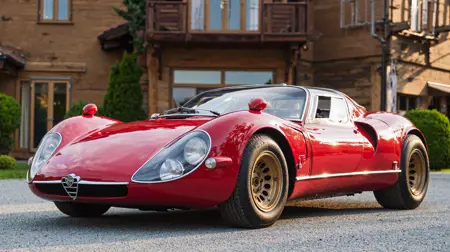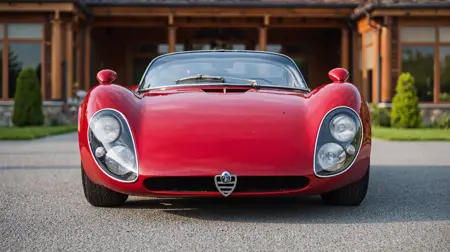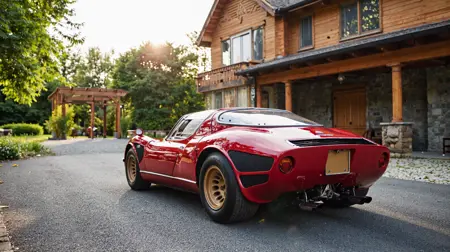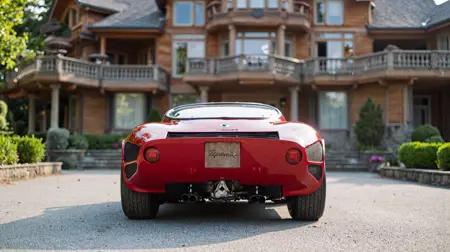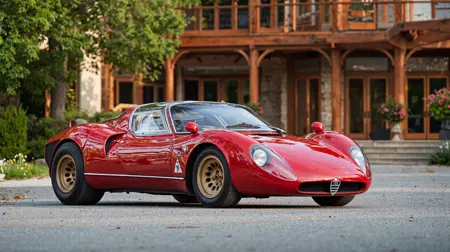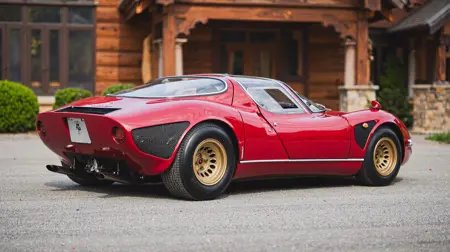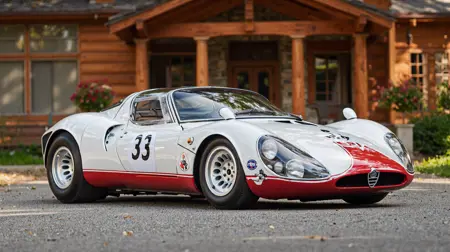Alfa Romeo 33 Stradale - 1967
Details
Download Files
About this version
Model description
The Automotive Mona Lisa: A Portrait of the Alfa Romeo 33 Stradale
In the history of the automobile, few cars have achieved the mythical status of the 1967 Alfa Romeo 33 Stradale. Widely regarded as one of the most beautiful cars ever created, it is a rolling sculpture born from the crucible of motorsport and the genius of Italian design. The Stradale is the ultimate expression of Alfa Romeo's "Necessary Beauty" philosophy, where breathtaking mechanics and sublime style are one and the same. It is a rare example of a road car derived directly from a purpose-built racing machine, a fact that defines its character, its performance, and its enduring legacy.
The car's story begins on the race track. In 1964, Alfa Romeo president Giuseppe Eugenio Luraghi initiated an official return to motorsport, acquiring the race-prep firm Autodelta and placing the brilliant engineer Carlo Chiti at its helm. The resulting "33 project" was a sophisticated Tipo 33 race car, which, on its debut in March 1967, won the Fléron hillclimb in Belgium. This victory created a wave of excitement that directly catalyzed the creation of a road-going ("Stradale") version to capitalize on the public's imagination.
To clothe the race-bred chassis, Alfa Romeo commissioned master stylist Franco Scaglione. With a background in aeronautical engineering, Scaglione sculpted a body that was a masterclass in functional beauty, where every sensual curve served an aerodynamic purpose. Standing just 99 cm tall, the car required an innovative solution for entry and exit, leading to its most iconic feature: forward-hinged butterfly doors, a first for a production vehicle. These doors allowed the side windows to curve seamlessly into the roof, creating a panoramic, cockpit-like feel.
Beneath this stunning aluminum shell lay the heart of a purebred racer. The Stradale was powered by a 2.0-liter V8 engine, a detuned version of the full-race motor designed by Giuseppe Busso and refined by Chiti's Autodelta. Retaining its racing counterpart's flat-plane crankshaft, the all-aluminum engine produced around 230 hp and screamed to an astonishing 10,000 rpm redline. This powerplant was mounted in a modified version of the race car's tubular chassis, which was extended by 10 cm for slightly more cabin space. Combined with a fanatical dedication to lightweight construction—the car weighed a mere 700 kg (1,543 lbs)—the Stradale delivered breathtaking performance from a small-displacement engine, accelerating from 0-62 mph in under six seconds.
Despite its technical brilliance and sublime beauty, the 33 Stradale was a commercial failure. Its staggering price of $17,000 in 1968 made it the most expensive car in the world, costing significantly more than a contemporary Lamborghini Miura. This, combined with a difficult, hand-built production process plagued by clashes between Scaglione's artistic perfectionism and Autodelta's racing pragmatism, meant that an original plan for 50 cars was cut short. Between 1967 and 1969, only 18 chassis were ever produced.
This commercial failure ironically cemented the Stradale's immortality. The extreme scarcity—with fewer than a dozen original road cars completed—is the foundation of its modern-day legend as a "blue-chip" collectible, with private sales estimated to exceed $10 million. Furthermore, the car's failure in the marketplace secured a dual legacy. The five unsold chassis were given to Italy's great design houses—Bertone, Pininfarina, and Italdesign—to be used as a canvas for their wildest ideas. This resulted in a series of groundbreaking concept cars, including Bertone's wedge-shaped Carabo, whose scissor doors directly inspired the Lamborghini Countach, and Italdesign's Iguana, which influenced a generation of production cars.
Today, the 1967 Alfa Romeo 33 Stradale stands as a fixed point in automotive culture. It is a rare confluence of racing pedigree, engineering prowess, and unparalleled artistic vision. Its spirit of disciplined mass and sensual elegance continues to influence Alfa Romeo's design, most notably in the 2023 limited-edition homage that revives its legendary name. More than just a car, the 33 Stradale is a museum-grade object that still performs like a living machine—a true automotive Mona Lisa.
